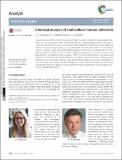Files in this item
Chemical analysis of multicellular tumour spheroids
Item metadata
| dc.contributor.author | Jamieson, L.E. | |
| dc.contributor.author | Harrison, David James | |
| dc.contributor.author | Campbell, C.J. | |
| dc.date.accessioned | 2015-06-10T10:40:03Z | |
| dc.date.available | 2015-06-10T10:40:03Z | |
| dc.date.issued | 2015-06-21 | |
| dc.identifier | 193150012 | |
| dc.identifier | 1ecce922-25ab-46a1-a697-79b51a31f750 | |
| dc.identifier | 84930747721 | |
| dc.identifier | 000355852400004 | |
| dc.identifier.citation | Jamieson , L E , Harrison , D J & Campbell , C J 2015 , ' Chemical analysis of multicellular tumour spheroids ' , Analyst , vol. 140 , no. 12 , pp. 3910-3920 . https://doi.org/10.1039/c5an00524h | en |
| dc.identifier.issn | 0003-2654 | |
| dc.identifier.other | ORCID: /0000-0001-9041-9988/work/64034354 | |
| dc.identifier.uri | https://hdl.handle.net/10023/6794 | |
| dc.description | This research received support from the QNano Project http://www.qnano-ri.eu which is financed by the European Community Research Infrastructures under the FP7 Capacities Programme (grant no. INFRA-2010-262163), and its partner Trinity College Dublin. | en |
| dc.description.abstract | Conventional two dimensional (2D) monolayer cell culture has been considered the ‘gold standard’ technique for in vitro cellular experiments. However, the need for a model that better mimics the three dimensional (3D) architecture of tissue in vivo has led to the development of Multicellular Tumour Spheroids (MTS) as a 3D tissue culture model. To some extent MTS mimic the environment of in vivo tumours where, for example, oxygen and nutrient gradients develop, protein expression changes and cells form a spherical structure with regions of proliferation, senescence and necrosis. This review focuses on the development of techniques for chemical analysis of MTS as a tool for understanding in vivo tumours and a platform for more effective drug and therapy discovery. While traditional monolayer techniques can be translated to 3D models, these often fail to provide the desired spatial resolution and z-penetration for live cell imaging. More recently developed techniques for overcoming these problems will be discussed with particular reference to advances in instrument technology for achieving the increased spatial resolution and imaging depth required. | |
| dc.format.extent | 2247700 | |
| dc.language.iso | eng | |
| dc.relation.ispartof | Analyst | en |
| dc.subject | RC0254 Neoplasms. Tumors. Oncology (including Cancer) | en |
| dc.subject | T-NDAS | en |
| dc.subject | SDG 3 - Good Health and Well-being | en |
| dc.subject.lcc | RC0254 | en |
| dc.title | Chemical analysis of multicellular tumour spheroids | en |
| dc.type | Journal article | en |
| dc.contributor.institution | University of St Andrews. School of Medicine | en |
| dc.identifier.doi | 10.1039/c5an00524h | |
| dc.description.status | Peer reviewed | en |
This item appears in the following Collection(s)
Items in the St Andrews Research Repository are protected by copyright, with all rights reserved, unless otherwise indicated.

